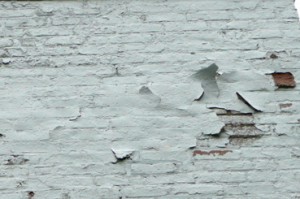Paint restoration sometimes requires starting over, especially when it comes to painted brick. Painting brick is not a good idea, especially when you are dealing with common brick. Common brick was fired at a lower temperature and was therefore softer than face brick. Common brick was usually used on the rear and sides of buildings. Face brick was used on the front of the house and was much harder and durable, and also more expensive. So, why is it not a good idea to paint brick?
Brick structures are designed to breathe and let moisture escape out through primarily the mortar joints, which are purposely made a lot softer than the bricks it is holding in place. Mortar is the sacrificial component of masonry. In the process of acting as a transport for moisture, it eventually falls apart, but the bricks stay intact. When painting contractors paint brick, it interferes with the design of the masonry and, therefore, the moisture gets trapped. It finds its way inside of the building, or causes the paint to fail and the brick to deteriorate, or both.
The first picture shows what can happen when common brick is painted: paint peels and brick spalls, as indicated in the right side of the picture. Then, what is the solution to this problem? The next picture gives a clue as to what the solution is.
The white substance you see on the exposed brick area is limewash, which has been used through the ages to beautify masonry structures. Unlike paint, limewash becomes one with the masonry and allows it to breathe and act as it was intended to. There are countless European masonry structures finished in this way.
Unfortunately, if brick has been painted and problems like this occur, the remedy will entail the stripping of the layers of paint. The work will also likely include the replacement of the spalled bricks and the re-pointing of the failed joints with similar mortar. This work will have to be done before limewash can be applied. In order to achieve an opaque look, three or four coats of limewash will have to be applied. Over time, when the limewash wears off, one or two more coats will rejuvenate the look.
As indicated at the outset, paint restoration sometime requires starting over. This is the kind of knowledge and resources Painting in Partnership brings to bear on its work on older homes and “period” homes, in the Chicago area.









 Follow
Follow
